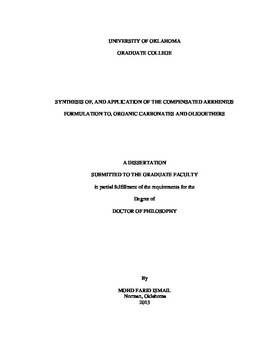| dc.description.abstract | It has been proposed and shown that transport properties like self-diffusion and ionic conductivity in organic liquids are dependent on the dielectric constants and the activation energies in these liquids. The formal method that relates the self-diffusion and ionic conductivity to the dielectric constants and activation energies in these liquids is called the Compensated Arrhenius Formalism (CAF). Various systems have shown to be in compliance with the CAF.
The CAF has been applied to liquids of varying dielectric constant values. In order to extend the library of the solvent applicable for analysis by the CAF and to understand the limitation of the CAF, two organic liquids, one with very low dielectric constant, acyclic carbonates, and the other with very high dielectric constant, cyclic carbonates are synthesized and analyzed using the CAF. The CAF is also tested for analysis of transport properties in polymers.
This thesis involves the synthesis of acyclic carbonates, cyclic carbonates, and oligomers of poly(ethylene oxide), and the application of the CAF to these organic liquids and oligomers in order to try and understand the limitations of the CAF. The application of the CAF to these liquids and oligomers also can help in trying to understand the transport properties in these liquids and in polymers.
The synthesis of asymmetric acyclic carbonates was accomplished using a convenient method where an unwanted secondary reaction was avoided by precipitation of a side product during the reaction. The cyclic carbonate derivatives were synthesized via the cyclization reaction of methyl chloroformate and 1,2-diols. The synthesis of poly(ethylene oxide) oligomers was achieved using simple SN2 reactions with alkyl bromide.
The transport properties of acyclic carbonates and the cyclic carbonates can also be described by the CAF. Acyclic carbonates have low dielectric constants, but similar energy of activation for self-diffusion as other higher dielectric constant organic liquids like 2-ketones, nitriles, and acetates. The low dielectric constant values of acyclic carbonates prevent salts from dissolving in acyclic carbonates. Thus the conductivity in acyclic carbonates could not be measured.
The cyclic carbonates have high dielectric constants. The energy of activation for self-diffusion of cyclic carbonate is higher compared to other aprotic organic liquids previously investigated. The energy of activation for ionic conductivity is also found to be high for cyclic carbonates compared to other polar aprotic liquids like 2-ketones and nitriles. The energy of activation is very high such that even though the dielectric constant in cyclic carbonates is higher than the dielectric constants in 2-ketones and nitriles, the conductivity is lower in cyclic carbonates.
It was found that the CAF can be applied to oligomers of poly(ethylene oxide). However, the results suggest that to apply the CAF to oligomers and predict transport properties in polymers, the oligomers repeat units have to be high compared to the alkyl chain length tethered to the oligomers. | en_US |
